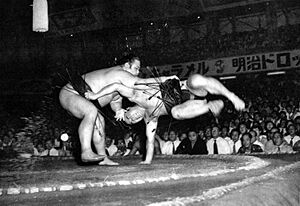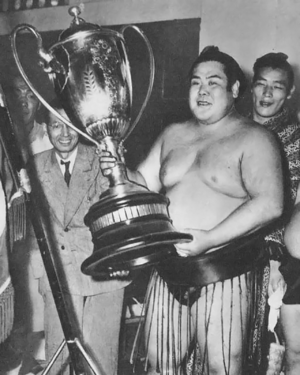Azumafuji Kin'ichi facts for kids
Quick facts for kids 東富士 欽壹Azumafuji Kin'ichi |
|
|---|---|

Azumafuji performing his yokozuna ring-entering ceremony, late 1948
|
|
| Personal information | |
| Born | Inoue Kin'ichi October 28, 1921 Tokyo, Japan |
| Died | July 31, 1973 (aged 51) |
| Height | 1.79 m (5 ft 10+1⁄2 in) |
| Weight | 178 kg (392 lb; 28.0 st) |
| Career | |
| Stable | Takasago |
| Record | 335-137-54-1draws-1hold |
| Debut | January 1936 |
| Highest rank | Yokozuna (October 1948) |
| Retired | September, 1954 |
| Elder name | Nishikido |
| Championships | 6 (Makuuchi) 1 (Jūryō) 1 (Makushita) |
| * Up to date as of June 2020. | |
Azumafuji Kin'ichi (Japanese: 東富士 欽壹, October 28, 1921 – July 31, 1973) was a famous Japanese sumo wrestler. He became the 40th yokozuna, which is the highest rank in sumo. After his sumo career, he also became a professional wrestler.
Contents
Azumafuji: A Top Sumo Wrestler

Azumafuji's real name was Inoue Kin'ichi. He started his professional sumo career in January 1936. He joined a sumo training stable called Takasago stable. By May 1943, he had worked his way up to the top sumo division, known as makuuchi.
Rising Through the Ranks
In November 1944, Azumafuji achieved a big win. He defeated the great yokozuna Futabayama. This was a very important victory for him. After two strong performances where he finished as a runner-up, he was promoted to ōzeki in June 1945. Ōzeki is the second-highest rank in sumo.
Azumafuji won his first top division championship in May 1948. Soon after, in October of the same year, he was promoted to the highest rank: yokozuna. This was a huge achievement! He even won his very first tournament as a yokozuna in January 1949.
A Special Match and Retirement
In September 1951, Azumafuji had a very unusual match. He was battling pneumonia but kept fighting because he had only lost once. During a match against ōzeki Yoshibayama, they fought twice, but neither could win. Azumafuji was too sick to continue. Yoshibayama, being a true sportsman, suggested they declare a "hold" (azukari). This means the match had no winner or loser. Azumafuji still went on to win that tournament, his fourth championship.
Azumafuji won his sixth and final championship in September 1953. After this, he started to struggle with injuries. In September 1954, he made a surprising decision. He announced his retirement from sumo. He did this so that another strong wrestler, Tochinishiki, could become a yokozuna. If Azumafuji had stayed, there would have been too many yokozuna at once, which was very rare.
Life After Sumo: Professional Wrestling
After retiring from sumo, Azumafuji made a big change. He became the first yokozuna to switch to Western-style professional wrestling in 1955. He wanted to avoid some disagreements happening within the Japan Sumo Association at the time.
From Sumo Ring to Wrestling Ring
In April 1955, he teamed up with another former sumo wrestler, Rikidōzan. Together, they won the Hawaiian Tag Team title in Honolulu. In 1956, Azumafuji won the Japanese Heavyweight tournament by defeating Toshio Yamaguchi. This win was supposed to lead to a match against Rikidōzan, who was the Japanese Heavyweight Champion. However, that big match never happened.
See also
- Glossary of sumo terms
- List of past sumo wrestlers
- List of sumo tournament top division champions
- List of yokozuna



